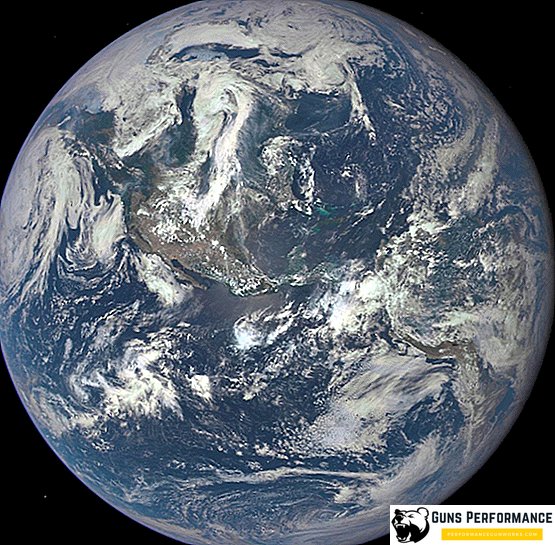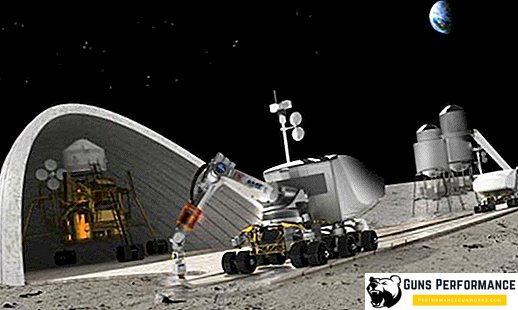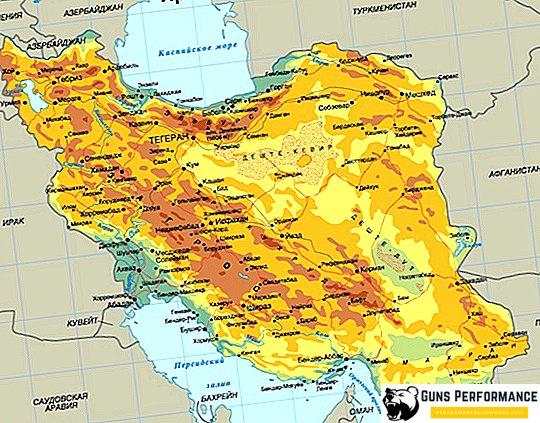
The history of our planet was very turbulent, and not always it was so cozy and hospitable as it is today. Planet Earth is a very active world that is in continuous development. The outlines of the continents and oceans are changing, albeit slowly, the climate is different. Even more dynamic in its development is the biosphere - the living shell of our planet. In the last millennia, another factor appeared on the Earth, cardinally influencing its appearance - man. But this is a separate topic, and before moving on to it, one should give a general description of the planet and the place it occupies in the Universe and in which galaxy it is located.

Earth in space or our astronomical address
We are in one of the many galaxies called the Milky Way. It has about 200 billion stars of various types, it has the shape of a spiral, which slowly rotates around its center.
The sun does not occupy a central position. It is located in one of the branches of the galactic spiral - Orion's belt. The distance from the star to the center of the Milky Way is 26 thousand light years.

The sun is the only star of our system. According to astronomical classification, it refers to the type of yellow dwarfs, and mainly consists of hydrogen and helium. In its composition there are other elements, but they are few. By cosmic standards, our star is quite an ordinary star. Their number even in the visible part of the universe is very large. In the depths of the Sun, thermonuclear reactions continuously occur, during which hydrogen is converted into helium and a huge amount of energy is released, due to which life on planet Earth is possible.

The emergence of life on our planet was made possible thanks to the happy coincidence of a number of circumstances. Among them: a significant mass, sufficient to keep the protective layer of the atmosphere, the presence of a magnetic field that protects various life forms from destructive cosmic radiation and the presence of large amounts of water on planet Earth. However, the main uniqueness of our planet is its orbit. It is the “successful” distance to the Sun that creates favorable conditions for life on planet Earth. If it was a few percent more or less, then probably living organisms on it would not have appeared. In addition, the Earth is the only planet in the solar system with such huge reserves of water, without which the emergence of life would be impossible. Scientists argue where it came from, and why it did not happen on Mars and Venus - the closest planets to Earth.
The movement of the planets takes place almost in circular orbits, which form an almost flat disk called the ecliptic plane. Features of the Earth's rotation and the tilt of its axis determines the change of the time of year.
The neighbors of the planet Earth are Venus and Mars. Devices created by man, already landed on these space bodies, is currently under active study of Mars. Several countries are planning to send astronauts to the planet. The planet closest to Earth is Venus, it is a lifeless hot ball, where the surface temperature can reach the melting point of lead.
Earth has one natural satellite - the moon. Until now - the only celestial body, where the human foot has gone. This is a rocky ball, covered with craters in abundance, which moves around the Earth in an elliptical orbit. Lunar rotation determines the alternation of tides in the oceans of our planet. On the moon traces of water were found, it is possible, like the Earth was inhabited.
Recently, the Moon and Mars are present in the news of astronautics. It is assumed that humanity will be able to build a permanent station on our natural satellite and send an expedition to Mars. This will happen in the next decade. Scientists hope to find at least traces of organic life on Mars.
General description of the planet Earth
So, our planet is a small rocky ball, partially covered with water, located on the third place from the Sun. What are the real dimensions of the planet Earth?
Its average radius is 6,371 km, and its surface area is 510,072 million km², of which water is 361,132 million km², and land - 148,940 million km². The diameter of the planet Earth is 12,742 km.
In fact, the Earth is not a ball. So easy to assume. The real shape of the planet is a spheroid, somewhat "flattened" at the poles and "elongated" near the equator.
The total weight of the planet Earth is 5.9726 · 1024 kg., Which is 81.3 mass of the Moon, 0.0583 mass of Neptune and 0.00315 mass of the gas giant Jupiter. The average density of the substance of our planet is 5.5153 g / cm ³. The speed of rotation of the Earth at the equator is 1674.4 km / h.
Our planet mainly consists of several elements: iron (32.1%), oxygen (30.1%), silicon (15.1%) and magnesium (13.9%). At the same time, the overwhelming part of the iron is located in the core of the Earth (88%). In the earth's crust the most oxygen - 47%.

The acceleration due to gravity is 9,780327 m / s². To reach the Earth's orbit, the object must reach a speed of 7.91 km / s, and to overcome its attraction - 11.186 km / s.
Geographers divide the surface of the Earth into several hemispheres. The boundary of the Northern and Southern Hemispheres is the equator, and the Eastern and Western - the 180th and Greenwich meridians.
Scientists distinguish several shells or geospheres of our planet:
- the atmosphere;
- hydrosphere;
- lithosphere;
- biosphere.
Sometimes, apart from the lithosphere or hard shell of the planet, the pyrosphere is emitted, which is below the level of the earth's crust, it is distinguished by significant temperatures and molten contents. The core of the Earth, located in the very center of the planet and having a unique composition and characteristics, is considered as a separate shell.

Earth's history or how our big house was formed
The solar system was formed about 4.5 billion years ago from a huge cloud of interstellar dust gas. It consisted of hydrogen and helium, formed as a result of the Big Bang, and heavier elements arising in the depths of supernovae.
Under the action of inertial forces and gravity, this cloud began to shrink, forming the first planets of our system, including Earth. Scientists believe that the process of primary formation of the planet Earth took several tens of millions of years. They believe that the Moon appeared somewhat later, as a result of a tangential collision of the planet with another massive celestial body.
The impact of a huge force tore off part of its mantle from Earth and pushed this piece into orbit, where later the modern form of the satellite formed under the influence of gravity.
At that time, the outer space around our planet was filled with a huge number of small celestial bodies, which constantly bombarded its surface, heating it, and also increasing the size of the protoplanet. The temperature of the young Earth was high enough to melt metals and minerals, the heavier of them descended, which led to the formation of light crust and a dense earth core. Originally, the Earth’s surface was an ocean of molten magma, several kilometers deep. The high surface temperature for a long time supported the decay of radioactive elements such as uranium and thorium.

Volcanic gases formed the first atmosphere of the newborn planet, its surface began to cool gradually. About 4.4 billion years ago, most of the planet’s surface was already a hard crust and water appeared on it. The earth gradually turned into a water world: already four billion years ago, up to 90% of its surface was covered by the primary ocean. However, this world can hardly be called cozy and hospitable: the air of the atmosphere was almost entirely carbon dioxide, and its temperature reached 200 ° C, and the atmospheric pressure was so great that it would simply crush a person.
We love to repeat: "Our blue planet Earth", but it is still not clear where such large amounts of water came from on the planet. This is one of the many mysteries of the planet Earth. This question is fundamental to the emergence of life, but the controversy around it does not subside. There are several theories about how water was formed on our planet. According to one of them, water was brought to Earth by asteroids and meteorites, which fell on its surface in abundance billions of years ago. Geophysicists assume that it originated on our planet as a result of chemical processes in its depths. These two hypotheses do not contradict each other. It is possible that part of the water came to us from space along with the asteroids, and the other was formed on the spot.
3 billion 400 million years ago the first continents began to rise from the sea. Volcanic eruptions have formed a new rock - granite, which became the basis of the continental crust. The era of ocean domination has come to an end, it is time for land.
Together with the first oceans, well-warmed and sunlit shallows appeared, which became the cradle of life on planet Earth. Currently, there are several theories about how exactly this happened and scientists are still unable to come to a common opinion. The origin of life is another of the mysteries of planet Earth.
Common ancestors of all life forms on our planet were primitive prokaryotes, initially incapable of photosynthesis. Then the first photosynthetics appeared on the coast - cyanobacteria, which gradually began to saturate the atmosphere with oxygen. Scientists believe that life on planet Earth originated about 3.5-3.9 billion years ago. At the same time, the planet “acquired” a magnetic field that protected the atmosphere from the destructive action of cosmic radiation.
For two billion years, bacteria have saturated the ocean with oxygen, which was spent initially on the oxidation of millions of tons of iron dissolved in water. After that, this gas began to flow into the atmosphere, and our planet was transformed: the green oceans, having lost iron, turned blue, and the sky — blue. This happened about 1.5 billion years ago.
About 1.1 billion years ago, the first terrestrial supercontinent, Rodinia, was formed. Its surface, most likely, resembled the modern Sahara - a dull and empty place without any vegetation or other signs of life. The formation of this continent led to the first and largest glaciation in the history of our planet. Rodinia blocked warm currents to the poles, and the whole world was covered with ice for millions of years. The temperature dropped to -40 ° C, and the ice cover of the oceans reached kilometer thickness. This cataclysm happened about 750 million years ago. There was a real death of the planet Earth.
Volcanic processes were able to split Rodinia and gradually warm the planet. It is believed that the Earth finally woke up from hibernation only 580-560 million years ago. Unicellular living organisms were able to survive difficult times, and now their further development did not hold back. The so-called Cambrian explosion began.
This term is called a sharp increase in the diversity of life, which occurred about 550-540 million years ago. Cambrian generally holds a special place in the history of life on our planet. During this period, many modern types of organisms appeared, the animals developed a durable shell, they acquired organs of sight and teeth. The saturation of the atmosphere with oxygen led to the formation in it of a new layer - the ozone, reliable protection of all life from the murderous solar ultraviolet. Now one could begin to master the land.
In Ordovician, life on planet Earth first came to land. These were primitive lichens, and some of the arthropods laid eggs on the banks. In the Silurian period, vertebrates were finally formed, the presence of a hard ridge immediately provided them with significant evolutionary advantages.
Active conquest of land happened in the next, the Devonian period. It began 417 million years ago. At this time, the first forests appeared on the surface of the planet, consisting of primitive ferns and horsetails. Arthropods spun off a powerful evolutionary branch - insects that spread very quickly throughout the planet. In Devon, vertebrates - amphibians made their first step on land. At the end of this period, the first bony fish appeared in the reservoirs.
The Carboniferous period (354-290 million years) is the realm of insects, amphibians and huge horsetails and ferns. At this time on Earth it was very hot and humid, and the concentration of oxygen in the air far exceeded the current one. Due to such conditions, some insects of that time had gigantic sizes. It is believed that it was the Coal period that gave mankind the main reserves of coal and other fossil hydrocarbons. But this geological period ended with another global glaciation, which began about 290 million years ago.
In the Permian period (290-248 million years ago) the climate of the planet became drier and cooler. The place of amphibians on land was taken by reptiles, the first coniferous plants appeared. However, Perm is not famous for this: at its end, the largest and most catastrophic extinction of living organisms in the entire history of the planet occurred. About 95% of the species that lived on land and in the oceans died. Most likely, the apocalypse of a planetary scale caused a huge eruption of traps on the territory of modern Siberia. Almost all of it turned into a lake of red-hot magma. Moreover, these volcanic processes lasted for about 1 million years, a huge amount of gases was emitted into the atmosphere, which led to the onset of a volcanic winter.
We do not know why the colossal Permian eruption happened. It can be called one of the many mysteries of the planet Earth. However, this event completely transformed her appearance. A new supercontinent Pangea was formed, the gas composition of the atmosphere changed dramatically, the climate became different.
Creatures that could survive a terrible catastrophe, evolved into amazing animals - dinosaurs. These creatures dominated our planet for 160 million years; they mastered not only land, but also water and air. The weight of some dinosaurs reached 150 tons, and the length - 50 meters. Dinosaurs reigned on the planet throughout the Mesozoic era (248 - 64 million years ago), but the gigantic dimensions could not save them from a new global catastrophe that came to Earth from space.

Disputes over the causes of extinction of giant reptiles continue to this day, but the main one is that scientists consider the fall of a giant meteorite in the area of the modern Gulf of Mexico. This cataclysm plunged the planet into a volcanic winter for many years and led to the disappearance of 70% of living organisms.
65 million years ago began the Cenozoic era, in which we live today. During this period, the drift of lithospheric plates continued, and gradually the map of the world assumed familiar outlines. In the animal world, the place of dinosaurs was occupied by mammals, which had significant evolutionary advantages compared to lizards. Flower or angiosperms have become the dominant class of plants. The most important events of the Cenozoic era is another glaciation and the emergence of a rational man.
Atmosphere - the air shell of the Earth
The atmosphere is one of the geospheres of our planet, a shell consisting of gases that surround the Earth. It is in direct contact with outer space. The atmosphere determines the climate and weather on our planet. It is the atmosphere that in many respects provides favorable conditions for life on planet Earth.
It should be understood that it is quite difficult to draw a clear boundary of the atmosphere: it moves into outer space gradually, at an altitude of 500 to 1 thousand km. At the same time, the International Aviation Federation considers the upper boundary of the atmosphere to be 100 km, and the US NASA agency - 122 km.
The Earth's atmosphere consists of gases, as well as various impurities, such as dust, combustion products, water droplets, and ice crystals. The concentration of gases is almost constant. However, there are exceptions: for example, the beginning of the industrial revolution led to a continuous increase in carbon dioxide in the air.

The main part of the air (more than 78%) is nitrogen, 20% it consists of oxygen, almost 1% is argon, another one percent is carbon dioxide, methane, helium, xenon, hydrogen, krypton. Крайне важна концентрация диоксида углерода (CO2), потому что этот вещество - как и метан - относится к парниковым газам, увеличение содержание которых вызывает разогрев атмосферы. Глобальное потепление - это серьезнейшая проблема, стоящая перед современным человечеством.
Следует отметить, что Земля является единственной планетой с таким большим содержанием кислорода в атмосфере. С одной стороны, этот газ - продукт жизнедеятельности живых организмов, а с другой, жизнь на планете Земля без кислорода была бы невозможна.
Земная атмосфера состоит из следующих слоев:
- тропосфера;
- стратосфера;
- мезосфера;
- термосфера;
- экзосфера.
Между этими слоями расположены переходные зоны с переходными свойствами.
Все растения и животные, а также население планеты обитает на дне самого нижнего слоя атмосферы - тропосфере. Она простирается до высоты 16-18 км в южных широтах. В этом слое сосредоточена бо́льшая часть воздуха и водяного пара.

Стратосфера начинается на уровне 16-20 км и продолжается до высоты 50 км. В ней летает большинство авиалайнеров, также именно в стратосфере находится уникальный озоновый слой, защищающий все живое на планете от солнечного ультрафиолета.
На высоте 50 км начинается мезосфера, она простирается до высоты 80 км.
Между 80 и 700 км расположена термосфера, в которой проходит линия Кармана - официальная граница между атмосферой и космосом. Она находится на уровне 100 км.
На высоте 700 км уже экзосфера, доходящая до высоты 1 тыс. км. Воздух здесь сильно разряжен, его молекулы постепенно утекают в космическое пространство. В этом слое вращаются метеорологические спутники.
Гидросфера - жидкая оболочка планеты
Гидросферой называют водную оболочку Земли, в которую входит Мировой океан, реки, озера и водохранилища, подземные воды, а также вода, находящаяся в замороженном состоянии в составе ледников.
Земля является единственной известной планетой с таким огромным количеством воды на поверхности. Ее общий объем составляет 1,39 млрд км3. Подавляющая часть воды (более 96%) находится в морях и океанах, которые покрывают 71% поверхности нашей планеты. Средняя глубина Мирового океана составляет 3,8 тыс. метров. Самой глубокой его точкой считается Марианская впадина - 10 994 метров.

Любопытно, но пресная вода на поверхности суши - всего лишь 0,02% от общих запасов гидросферы, поэтому ее нехватка - это одна из самых острых мировых проблем современности.
Вода осуществляет сложный круговорот из одной части гидросферы в другую. В нем принимают участие другие геооболочки нашей планеты - атмосфера, литосфера и биосфера.
Твердая оболочка планеты Земля
Недра планеты имеют сложную структуру, состоящую из твердой коры, вязкой и жидкой мантии и очень плотного ядра. Кроме того, геологи выделяют у нее нескольких слоев:
- литосферу;
- астеносферу;
- мезосферу;
- внешнее и внутреннее ядро.
Литосфера - это твердая оболочка Земли, в состав которой входит земная кора и верхняя часть мантии до астеносферы. Существует два типа литосферы: континентальная и океаническая. Последняя имеет незначительную толщину, всего 5-10 км, кора континентальная типа простирается ниже поверхности на 80-100 км.

Литосфера разделена на литосферные плиты, которые подходят друг другу, как части головоломки. Они постоянно движутся, благодаря чему и происходит дрейф континентов. Подобным процессом вызвана тектоническая активность, которая проявляется в виде извержений вулканов, землетрясений, горообразования.
Астеносфера (100-700 км) находится на самой границе мантии и литосферы. Эта оболочка пластична, что позволяет литосферным плитам "ездить" по ней. Астеносфера, как и мезосфера, образуют мантию нашей планеты. Высокие температуры и колоссальное давление мантии делает горные породы пластичными и поддерживает постоянные конвенционные потоки от ядра к коре.
К сожалению, у нас мало точных данных относительно процессов, происходящих в земных недрах. Самая глубокая из пробуренных человеком скважин едва достигает 15 км - ничтожная величина по сравнению с тысячами километрами земной окружности. По понятным причинам мы не можем отправить вглубь Земли исследовательские аппараты и технику, поэтому ученым приходится довольствоваться косвенной информацией.
В центре нашей планеты находится плотное и раскаленное ядро, состоящее из никеля, железа и других тяжелых элементов. В настоящее время ученые различают внешнее жидкое ядро и внутреннее твердое. Температура в его центре достигает 6000 °С, что немногим меньше, чем на поверхности Солнца.

Ядро выполняет еще одну важнейшую функцию - его вращение создает магнитное поле Земли, которое защищает нас от убийственной солнечной радиации. По сути, планета - это огромный двухполюсный магнит. На Марсе, например, магнитного поля нет, и солнечный ветер за миллионы лет постепенно "выбил" атмосферу этой планеты, сделав ее абсолютно бесплодной. Ученые считают, что это одна из главных причин отсутствия жизни на красной планете.
Биосфера - живая оболочка Земли
Биосфера - оболочка планеты, заселенная живыми организмами, под этим термином подразумевается глобальная экосистема нашей планеты. Это часть Земли, на которой обитают различные формы жизни, и происходит воздействие их продуктов метаболизма.
Биосферу еще называют "пленкой жизни", данное определение, как нельзя лучше, иллюстрирует распределение и масштаб биосферы. Это действительно тонкая пленочка, покрывающая стык атмосферы, гидросферы и литосферы. Несмотря на скромные размеры, значение биосферы для нашей планеты огромно: живые организмы начали преобразовывать Землю практически сразу после своего появления. Биосфера - это могучий геологический фактор.

В настоящее время на Земле насчитывается более 3 млн. видов растений, животных, микроорганизмов, грибов и водорослей. Человека также принято считать частью живой оболочки, но его хозяйственная деятельность - вернее, ее масштаб - уже давно вышла за ее рамки. Население Земли сейчас составляет около 7,5 млрд. человек.
Верхней границей биосферы считается высота 15-20 км. Выше в атмосфере организмы практически не живут: мешает низкая температура, разреженный воздух и высокий уровень ультрафиолетового излучения. В литосфере нижняя граница распространения жизни проходит примерно на глубине 5-7 км. Здесь ограничивающими факторами являются высокая температура и давление. Да и то на подобных глубинах живут немногочисленные "экстремалы", большинство форм жизни предпочитают верхний слой почвы. В гидросфере жизнь распространилась до самых мрачных глубин Мирового океана. Но подавляющая часть биомассы моря приходится на его верхние слои с большим количеством солнечного света и кислорода.
Биосфера активно участвует в круговороте веществ и энергетических потоках в природе. Энергия Солнца, попадая на Землю, частично аккумулируется растениями и другими фотосинтезирующими организмами. В дальнейшем часть ее запасается в торфе, угле и нефти, идет на выветривание горных пород, на создание пород осадочного происхождения. Живые организмы также участвуют в круговороте СО2, Н2О, О2, многих других химических элементов. Типичным примером воздействия живых организмов на неживую материю является образование почвы. В создании этого слоя принимают участие микроорганизмы, животные, растения, грибы.
Деятельность человека оказывает огромное влияние на биосферу. С каждым годом население увеличивается, что требует еще больше ресурсов и новых площадей под проживание, посевы, предприятия. Это приводит к уничтожению лесов, распахиванию степей, осушению болот. Наступление человека на природу стремительно уменьшает видовое многообразие, отходы нашей хозяйственной деятельности загрязняют воздух, почвы и воду. Такая ситуация приводит не только к разрушению экосистем, но и вызывает климатические изменения, последствия которых могут быть катастрофическими.
Наши предки считали планету живым организмом, называли "Мать-Сыра Земля", "Земля-матушка" и обожествляли ее. Согласно священным книгам, из земли было создано тело первого человека. И пускай подобные представления в высокотехнологичном XXI веке кажутся смешными и нелепыми, но человечество уже в ближайшие годы ожидают серьезные проблемы, если мы хотя бы не попытаемся думать схожим образом. В последние годы мы являемся свидетелями кардинального переворота в научных представлениях о строении, составе и жизни планеты, еще более удивительные открытия ожидают нас в будущем. Земля - это сложнейшая и высокоорганизованная система, требующая к себе бережного и рачительного отношения. Без понимания этого мы рискуем повторить печальную судьбу динозавров.












